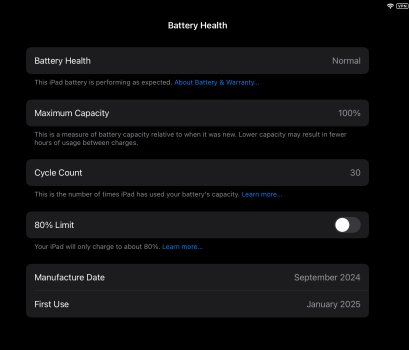I have an iPad 2 on iOS 9 with 800 cycles and 93% battery health. I have a theory that differs from yours.
Mine is that older versions of iOS (pre-iPadOS) did not impact battery life much, so for instance updating from iOS 6 to iOS 10 made little difference, especially in terms of standby drain. However back then iPads were extremely limited RAM-wise, so those updates destroyed performance.
iPadOS had a sizeable impact on battery life and standby drain. Not all at once but progressively, the more you updated. Today's iPads are much worse than Android tablets in terms of standby, while it used to be the opposite, and I know what I am talking about with 10 iPads and 7 Android tablets of different generations.
Performance is no longer an issue, even with 3-4GB RAM but reloads are. With 6-8GB even reloads are not an issue for now. And performance will never be an issue with M-series.
As for battery life, it's hard to predict.
Having said that, and that's where we differ, the degradation with updates was not linear and the OS of launch theory is not valid in my opinion. The difference between pre-iPadOS and post-iPadOS is massive, but over the past few OS versions, it's not big. It's there, but not massive. Could things change? For the worse? Sure. For the better? Possible but unlikely.
My strategy is staying always at least 1 OS generation behind to get feedback. And to avoid some updates completely, especially at the end of the life cycle if they are known to impact performance. I am not too worried about updates impacting battery life (read, essentially standby time, I don't care about screen on time since I don't drain my iPads completely and regularly charge them and have many), it's already bad enough like it is, so there is little to lose.
As for my 2TB M1, it's mainly sits in a drawer off. Why? Because my 1TB 2018 does everything I need. I only use it when I need windows too. And sure, at some point in the future it may replace my 2018, but for now it stays off at 50%, losing hardly any battery heath, still at around 103-104%.
So why did I buy it? Because I found 1 new for $800, and that's the only way to run Windows on iPad today (having a non updated M1, ideally with 16GB RAM, because Apple removed hypervisor from iPadOS 16.3).
No, I agree: 32-bit iPads maintained practically (not completely, but almost) like-new battery life through all iOS updates, but like you said, they obliterated performance to the point of uselessness. Future iOS updates, up to a point, reverted it: performance is significantly better than it was back then, but they killed battery life (see early 64-bit iPads significantly or fully updated).
The interesting aspect about standby… is that it sucks on original iOS versions, too! This started on iOS 12 (or 11, not sure because I never used it on iPhones) and iPadOS 13 on iPads. My iPhone Xʀ on iOS 12? Poor standby battery life. My Air 5 on iPadOS 15? Poor, too! This is updates-agnostic, sadly. It was iPadOS on iPads, though, because my 9.7-inch iPad Pro on iOS 12 has great standby battery life.
Agreed in terms of performance with newer iPads. The issue today is battery life. And perhaps for some newer models it’s not an issue yet, but it will be in the future… which goes back to the thread itself: cycling an iPad so as to make it interesting is hard. You need to have an iOS version that doesn’t kill battery life (not necessarily the original, you can push a little), you need to be a heavy enough user so as to put in more than 1000 cycles, and you either need multiple iPads or you need to do it fast enough before compatibility is gone. Tough, especially with a good iOS version.
My highest monthly average on an original version iPad is 11 cycles/month, which is nowhere near enough. And that average plummeted afterwards. Because even if (and I agree for some models) battery life isn’t an issue now, it will likely be in the future (keep in mind that support has skyrocketed, iPads were supported through fewer major versions), which kills any interesting health-to-cycles-to-SOT number. Tracking a device that has been killed by iOS updates is not interesting to me. For me, they have no value. My 9.7-inch iPad Pro has no longevity value (or very little). Non-updated iPads lose usability (and therefore, relevance) once they get too old so as to use them on their original iOS version. What can you do with an Air 2 on iOS 8? Well… not much.
Only the heaviest users can make that number interesting in five years. I’m talking gaming at high brightness and things like that, throughout the whole lifecycle. Otherwise they end up with 700-800 cycles, and I know that’s not enough to cause any impact on original iOS versions.
With so many iPads I think that for you battery in general is irrelevant. Like you said, you don’t need SOT and standby battery life is already poor on original iOS versions (I can confirm that, like I said).
If you’re not using the iPadOS 15 iPad, then it’ll never get to that point. And in my humble opinion, it’s the most relevant iPad, as it will remain on its original iOS version, but it will never be used enough so as to get to a high number.






